After decades of dashed hopes and broken promises, Tail o’ the Pup, Los Angeles’s famous hot dog-shaped hot dog stand, will finally reopen.
The last we heard, this gem of novelty architecture was heading to the Valley Relics Museum in Chatsworth, where it would be on display but wouldn’t dish out franks.
Now, just in time for National Mustard Day (yes, it’s a holiday and it happens the first Saturday in August) comes word that the 1933 Group has acquired the landmark — and plans to bring it back as a restaurant.

Two customers eat at Eddie Blake’s Tail o’ the Pup, a famous hot dog stand located at 300 N. La Cienega Boulevard. (David Clarke from the Security Pacific National Bank Collection via Los Angeles Public Library Collection)
The 1933 Group owns a bunch of bars around town — Bigfoot, Sassafrass, Thirsty Crow, Oldfield’s, a few others — all themed, often with a heavy vintage vibe. These are the folks who restored Highland Park Bowl to its Jazz Age splendor, resurrected the Idle Hour, a once popular North Hollywood bar and restaurant shaped like a giant barrel, and are in the midst of revamping the Formosa Cafe in West Hollywood. They respect the history of the venues they acquire and they seem to know what they’re doing, so fingers crossed that they’ll treat Tail o’ the Pup with the care it deserves.

The Idle Hour in North Hollywood was built in 1941 and renovated in 2015. (Photo by Mike Hume/Flickr Creative Commons)
Built in 1946, Tail o’ the Pup operated (not always at the same location) until 2005. After shuttering, it spent years moldering in storage facilities including a Torrance warehouse and a Lake Elsinore salvage yard.
Excited about eating at this landmark? You can thank Alison Martino, who runs Vintage Los Angeles. According to Los Angeles magazine, she spent years searching for the stand then working with the family of Tail o’ the Pup founder Eddie Blake to get it back. Now, the 1933 Group is looking for a new home for the Pup, somewhere street-facing in West Hollywood or Hollywood, near the stand’s original location.
Tail o’ the Pup is one of L.A.’s most famous examples of “programmatic architecture” — buildings designed to look like food, animals or other items — but it’s hardly the only one. Southern California has a rich history of buildings shaped like boots, owls, toads, pigs, airplanes and more. In fact, we were ground zero for the bizarre building boom.
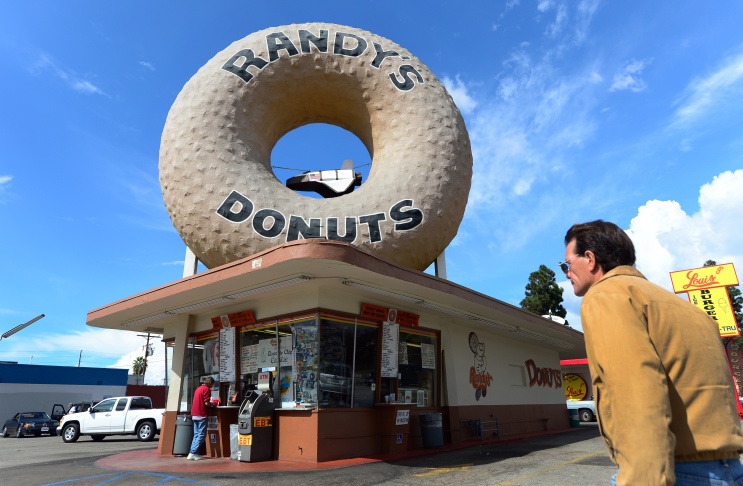
The giant donut on the roof of Randy’s Donuts is adorned with a mini Space Shuttle on October 11, 2012 in Inglewood. (Photo by Frederic J. Brown/AFP/Getty Images)
The trend reached its apex in the early 20th century. Motoring was still a new pastime and business owners wanted to catch the eye of passing drivers. Unhampered by modern building codes, they threw up these cool and kooky structures.
Sadly, most have been demolished. You can still see a few, including the famous Randy’s Donuts and a couple of old Chili Bowl locations
Fortunately, Southern California’s rich history of novelty architecture remains well documented.
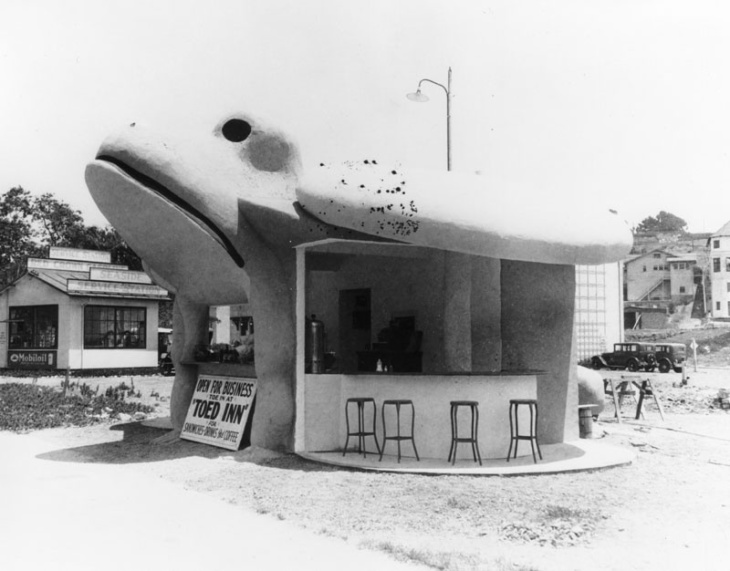
The Toed Inn, shaped like a frog, was originally located on on Channel Road in Santa Monica. After it was damaged by a flood in 1938, it was moved to 12008 Wilshire Boulevard in Westwood. (1920) (Photo via Los Angeles Public Library Collection)
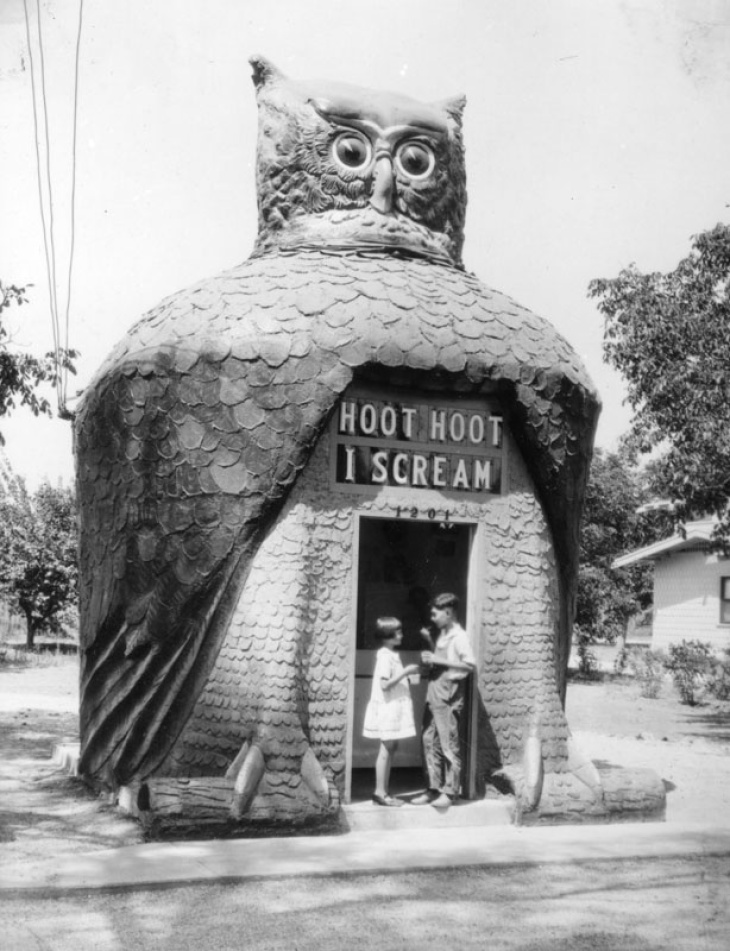
Shaped like an owl, the Hoot Owl Cafe had a head that rotated, blinking eyes made from Buick headlamps and a sign that read: “Hoot hoot, I scream.” It was designed by Roy Hattrup in 1926 – 27 and for more than 50 years, his wife, Tillie, ran it. It was originally located in Rosemead but was moved to two subsequent locations, both in South Gate, before being demolished in 1979. (Photo via Los Angeles Public Library Collection)
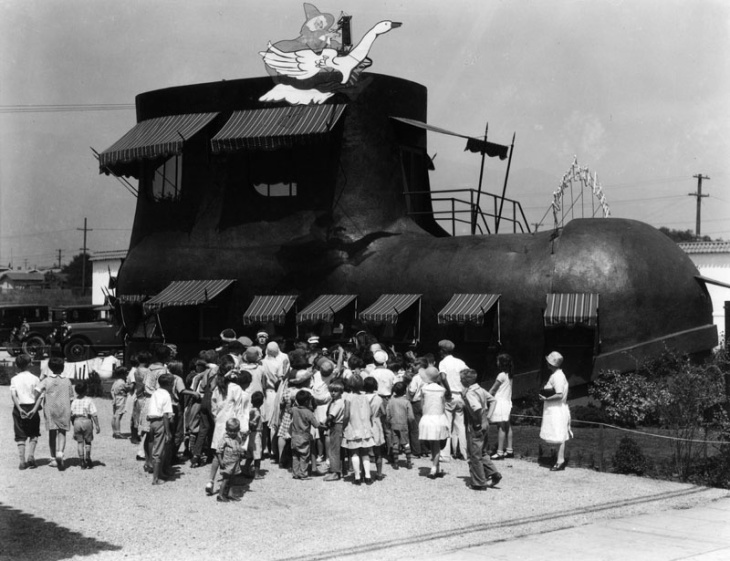
“There was an old woman, who lived in a shoe; she had so many children, she didn’t know what to do.” Apparently, she opened the Mother Goose Pantry at 1951 E. Colorado Blvd. in Pasadena. (1928) (Photo via Los Angeles Public Library Collection)

Launched in 1931 by former amateur boxer Art Whizin, the Chili Bowl chain had 22 outposts at its peak. Each building was round and shaped like a chili bowl with 26 stools around a circular counter where diners could get the signature dish: an open-faced burger blanketed with chili. This 1937 photo shows the original Chili Bowl, located at 3012 Crenshaw Boulevard. (Photo via Los Angeles Public Library Collection)

Although the exact L.A. location of The Airplane Café is unknown, the airplane-shaped restaurant came with wings, a propeller and wheels, although it rested on raised slabs of wood. (circa 1924) (Photo via Los Angeles Public Library Collection)
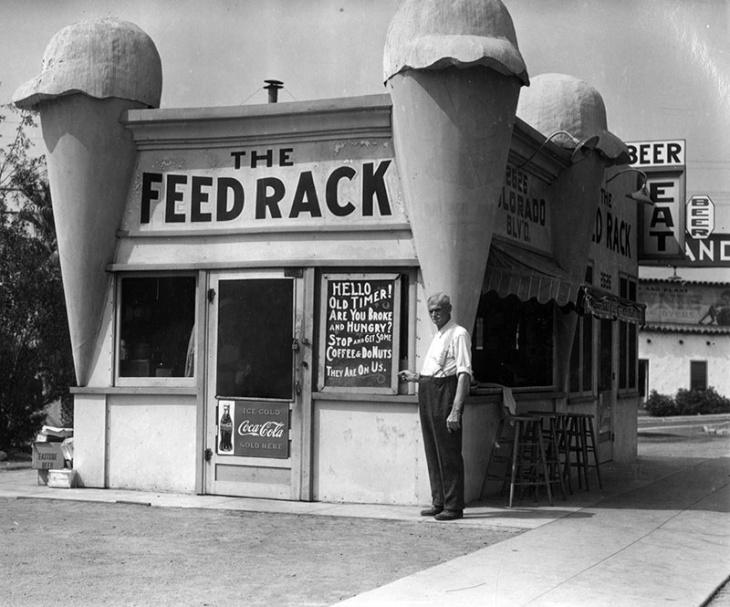
Originally built as an ice cream parlor with an oversized ice cream cone at each corner, the building became the Feed Rack restaurant during the Depression. Notice the sign: “Hello, Oldtimer! Are you hungry? Stop and get some coffee & donuts. They are on us.” (circa 1930) (Photo via Los Angeles Public Library Collection)
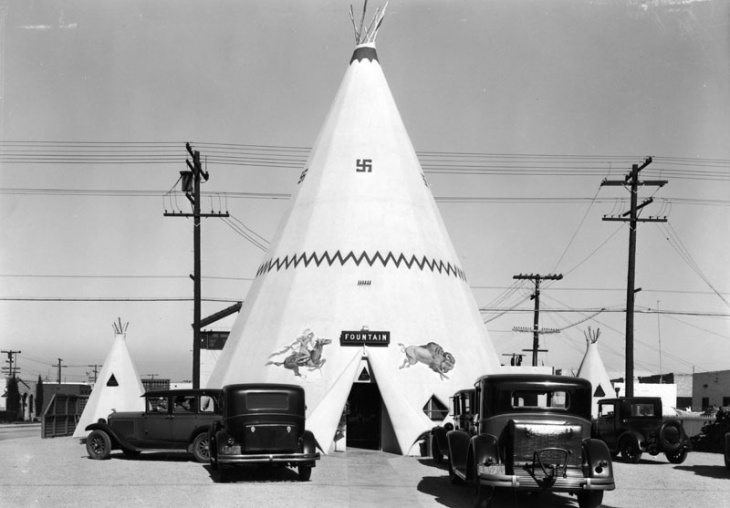
The Teepee was a popular ice cream stand in Long Beach on 2nd St. at Covina Ave, 1931. During this time, the swastika was commonly displayed as a positive symbol before the Nazi Party adopted it and gave it its hateful connotations. (Photo via Los Angeles Public Library Collection)
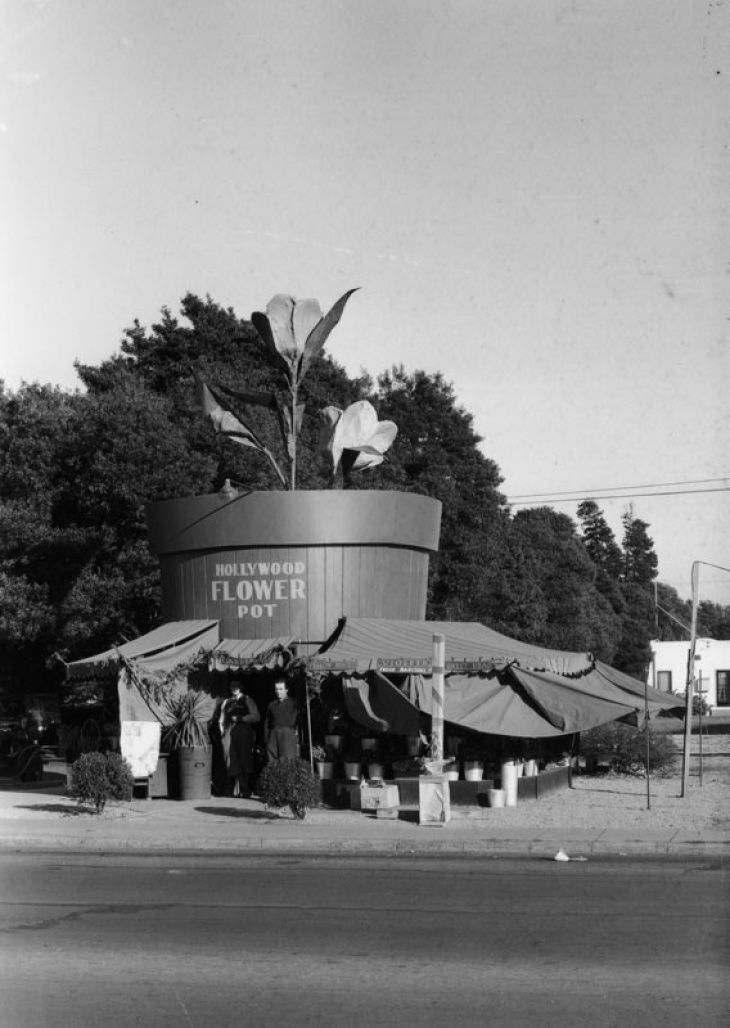
Located at 1124 Vine St. in Hollywood, the Hollywood Flower Pot is both the name of this flower shop and an accurate description of its facade. (1930) (Photo via Los Angeles Public Library Collection)
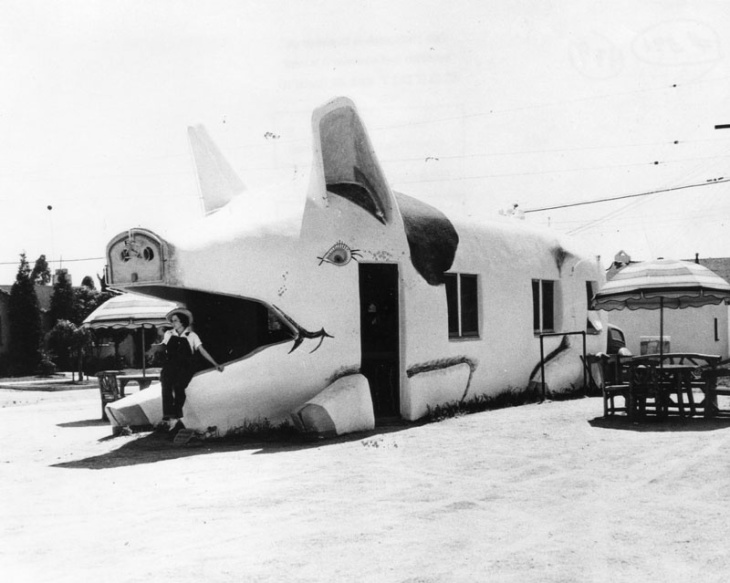
The Pig Cafe was built in 1934 near La Brea and Rosewood avenues in Hollywood. (Photo via Los Angeles Public Library Collection)

This photo of the Sphinx Realty Company, located at 537 N. Fairfax Ave. across from where Fairfax High School now stands, supposedly dates to 1920, so it’s too early for it to have been inspired by the Egyptology craze that swept the U.S. after Tutankhamun’s tomb was discovered in 1922. Notice the signs listing nearby properties for sale. Back then you could buy a six-bedroom, corner stucco house for $7,200. (Photo via Los Angeles Public Library Collection)
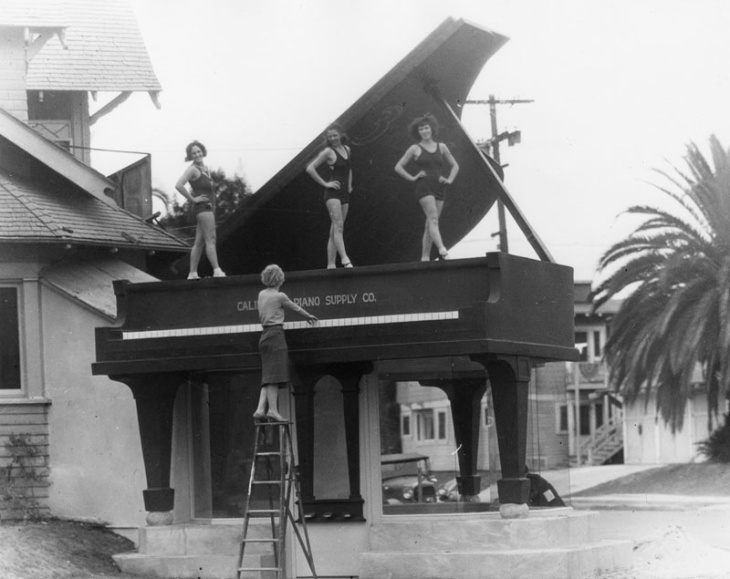
A giant grand piano marks the entrance of the California Piano Supply Co., which was renamed the Big Red Piano in the 1960s. (circa 1920s – ’30s) (Photograph via Los Angeles Public Library Collection)
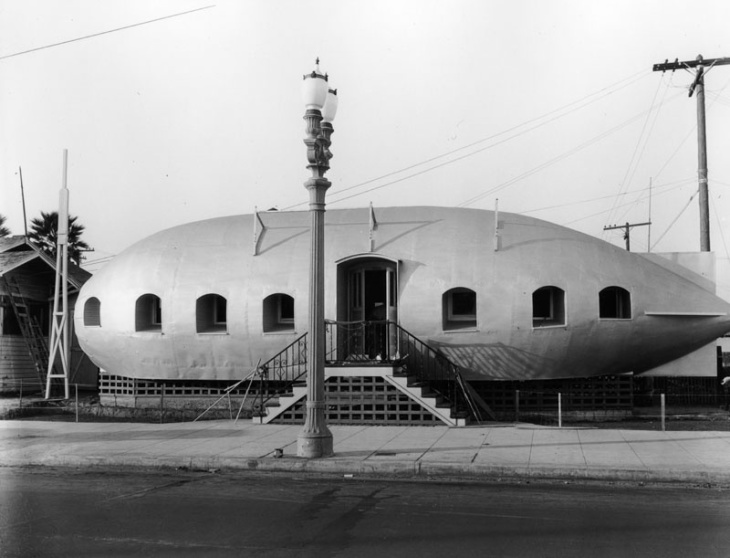
Shaped like a blimp (aka a zeppelin), the Zep Diner was located at 515 W. Florence Ave. near Figueroa St. (1931) (Photo via Los Angeles Public Library Collection)
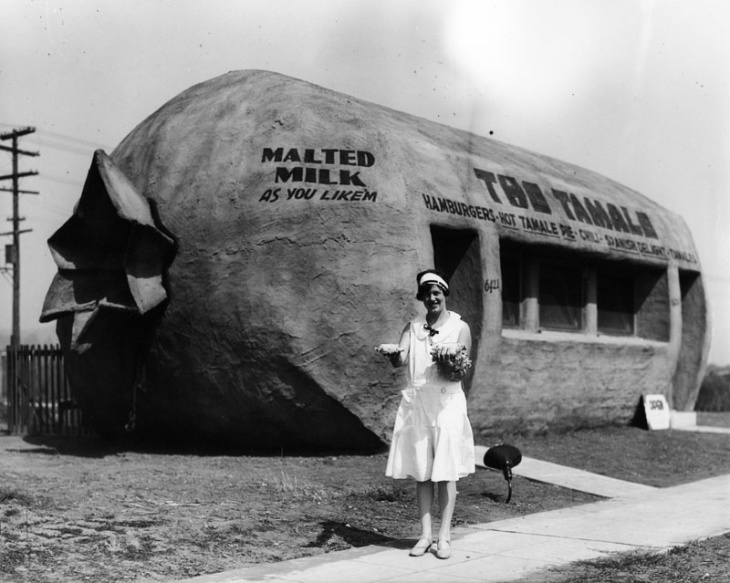
As its name suggests, the Tamale, located at 6421 Whittier Blvd. in East L.A., specialized in Mexican food as well as hamburgers, chili, malted milk and something called “Spanish delight.” The structure went on to become Charley’s Beauty Salon in 2001. (Photo via Los Angeles Public Library Collection)
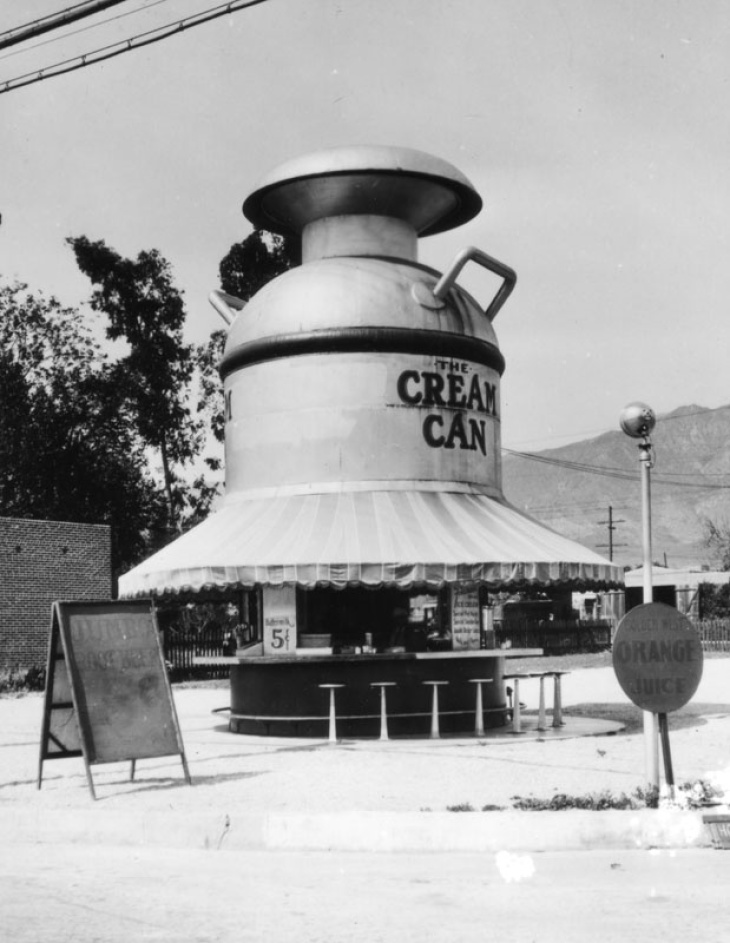
Shaped like a milk can, the Cream Can sold buttermilk (5 cents), orange juice, root beer and other beverages. (Photo via Los Angeles Public Library Collection)

Cars exit The Donut Hole drive-in restaurant, located on Elliot Avenue at Amar Road in La Puente, on January 4, 1983. (Herald-Examiner Collection/Los Angeles Public Library Collection)
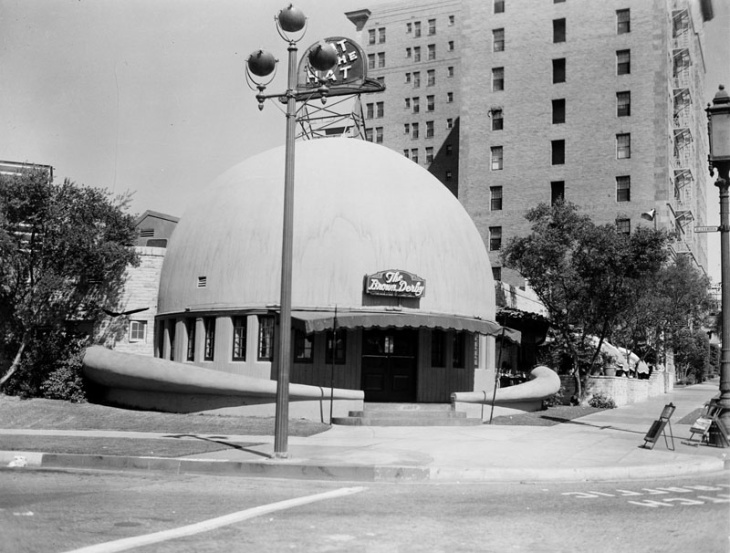
1934: Exterior view of the first Brown Derby restaurant at Wilshire Blvd. and Alexandria Ave., with its large “Eat in the Hat” neon sign atop the dome. There were four Brown Derby restaurants — in Beverly Hills, Los Feliz, Hollywood and Wilshire — but only this one, the original was shaped like a bowler hat. It was first located at 3427 Wilshire Blvd. but in 1937 was moved one block over to 3347 Wilshire Blvd. (Works Progress Administration Collection/Los Angeles Public Library)
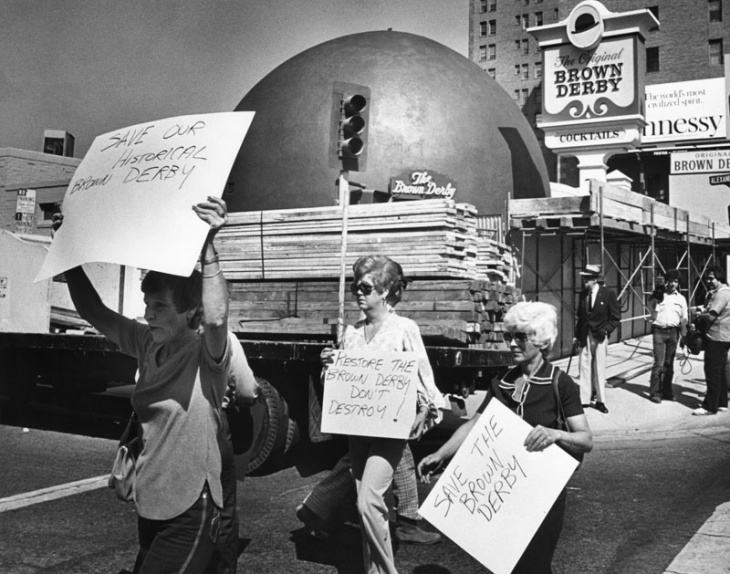
Picketers protest in front of the Brown Derby Restaurant on Wilshire Blvd., in 1980, hoping to prevent the restaurant from being razed and replaced by a high-rise. The restaurant had suddenly closed its doors after paying and dismissing employees. In September of 1980, it was torn down and replaced with a parking lot and later a strip mall with a domed structure on the third floor of the building, to resemble the original hat-shaped building. (Mike Mullen/Herald-Examiner Collection/Los Angeles Public Library)
Article courtesy of LAist.